Hi all! Well, it’s been quite some time since my last post, but with the news breaking last week that Microsoft acquired Datazen, I decided it was time to reenter the blogosphere to help folks get started using this fantastic product.
First things first, go grab the Datazen Publisher App from the Windows Store. Anyone can download and use Datazen on their Windows 8/8.1 device to build dashboards on top of local Excel files.
For most folks, however, they’ll want to use live data sources, make dashboards available on iPad/Android devices, phones, etc. To do all that, you’ll need to stand up a Datazen server to host the dashboards. Microsoft has made the Datazen server software available to download right away, provided you are a SQL Server Enterprise Edition customer with version 2008 or later AND have active Software Assurance coverage.
Assuming you meet those requirements, it’s very easy to get a single server instance up and running quickly by leveraging Microsoft Azure, and especially for test/dev scenarios. So I’m going to walk you through just how you would do just that.
This walkthrough assumes you already have a Microsoft Azure account and have a basic understanding of the Azure portal.
1. Go to azure.microsoft.com and login to your Azure portal.
2. Select New – > Compute -> Virtual Machines -> From Gallery
3. Select the Windows Server 2012 R2 Datacenter Image
4. Click the next arrow at the bottom right.
5. Enter a virtual machine name, choose Basic or Standard Tier (recommended), then choose A4 as the machine size. A4 has 8 cores, which is the minimum number of cores for a single machine setup. Enter the machine admin username/pass and hit the next arrow
6. Create a new cloud service (make sure the Cloud Service DNS Name is available), then choose the subscription it should be billed to, the region it should be deployed to (choose the one closest to your location), and then leave the Storage Account and Availability Set as is. Make sure you add an http endpoint at a minimum (you will need to scroll to add the endpoint).
7. Click the right arrow and then click the checkmark to start the deployment process. You’ll see it start the provisioning process in the list of the virtual machines you are responsible for in Azure.
8. Once it is finished, connect to the VM via Remote Desktop and enter the admin username/password
Head to the following link and download the Datazen server software onto the VM – you can save it anywhere you will be able to easily access it. You may need to turn off IE Enhanced Security on the server to do so. Click the “Configure this local server” link in the Server Manager dashboard that appears when you login
Then change the IE Enhanced Security Configuration from “On” to “Off” for Administrators at a minimum. You can always change it back if you really want to when you’re done.
9. The server files come zipped as a download – extract all the files and then run the executable to start the install process
10. Click Next through the wizard, accepting the terms in the License Agreement and moving through each screen.
Hit Next
Hit Next
Hit Next
Once you get to the password screen, choose a password for the Datazen admin. This doesn’t have to be the same password as you used for the server.
Leave the authentication mode as “Default” and hit Next.
Create a new text file on the desktop and copy the encryption key on the next page to it. Save the file to somewhere safe. Hit Next
Same thing for the instance ID – copy the information to a local text file then save it somewhere safe. In fact it won’t let you proceed until you add it your clipboard. Hit Next when done.
Leave credentials as is and hit Next.
Leave IIS settings as is and hit Next
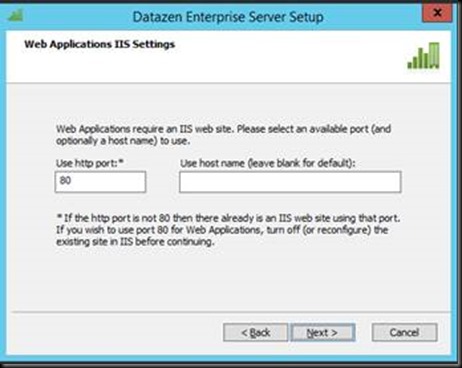
You can leave the mail settings as is if you want since it is a test server and just hit next. (I’ll go over how to setup the mail settings for this server in a short follow-up blog post sometime in the near future.)
Hit Install and wait until it is complete. It will take a few minutes to finish, so be patient.
To confirm the service was installed properly and can be reached from the public internet, open a web browser on your local machine and go to (make sure you replace the yourcloudservicename with whatever you named your cloud service) – http://yourcloudservicename.cloudapp.net/cp. If you can successfully connect, you should see the following in your browser window –
Enter the username “admin” and the password you entered DURING THE INSTALL WIZARD and hit Log In. You’ll then be brought to the control panel screen.
You’ll need to create a new user to start creating dashboard hubs, since you need each hub to have an owner. The owner can NOT be the “admin” user. Click “Create User” to create your first user –
Enter the top three boxes (the email address can be fake if you want) and hit “Create User”
You’ll now see a new option to “Create BI Hub”
To create a new hub, click the “Create BI Hub” button and enter the info. You can name the hub whatever you’d like, but make sure you enter the username of the user you just created.
Hit Create to finish creation of the hub. You’ll now see it in the list of available hubs
along with a new set of menu options on the bottom of the left-hand side of the screen.
At this point, I’d recommend finishing the setup of the user you’d created to be the hub owner. They need to have their password reset, but won’t get an email since we didn’t setup the email notification service with proper email settings. To get around this, click on the Server Users link on the left-hand side of the screen
You’ll see the user and a “Set Password Link” option next to the username. Click it and then copy the address to your clipboard.
Log out as the admin before completing this next step. You can logout in the upper right hand corner of the browser and hit the dropdown arrow. Choose Logout.
Open a new browser window and paste the URL into the address bar. You can now finish setting up that user by entering the password you want for the account.
Once you’ve completed the process, you should be brought into a new screen as the user you just finished completing and have the ability to configure the hub accordingly.
Logout as this user and log back in as the admin before proceeding.
One of the great features you get with Datazen is the ability to use custom branding for the server and for each dashboard hub you create. To add a brand package you’ve created, click on the branding link on the left hand side and simply upload the brand package to the server. Make sure you choose the Server to upload it to, and not the hub.
You’ll now see the Server icon has the “Microsoft” branding associated. To make sure it was applied properly, open a new browser and enter the following url (make sure you replace the mycloudservicename with whatever you named yours) –
http://mycloudservicename.cloudapp.net
My viewer login screen has been updated, since I’ve added the Microsoft brand package to the server –
Now we can connect to the server you’ve setup from the Datazen Publisher App. If this is the first time using the app, you’ll have the option of connecting the Datazen Demo server. I recommend going ahead and doing that, so you’ll have some nice demo dashboards to create from immediately.
To add this server as an additional server to connect to (and publish to, eventually), right-click on the bottom of the app and select the server icon.
A fly-out will come from the right-hand side showing the list of servers, followed by an option to add a new server connection–
Choose “Add New Server Connection” and enter the information for the server you just setup. MAKE SURE YOU UNCHECK THE “Use Secure Connection” box.
When that’s done, you should be connected and now be able to publish dashboards to your Datazen server!
To learn more about how to build dashboards, setup data sources, how to publish, etc., just use the PDF file that came with the server download titled “Datazen End User Documentation”.
There you go – hopefully this guide gives folks what they need to get started with Datazen and begin their new career as a dashboard designer extraordinaire!
Thanks, and feel free to ask any questions in the comments.

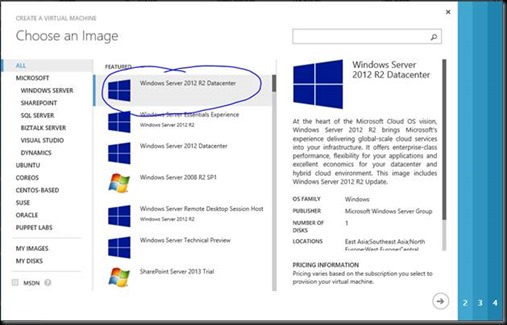
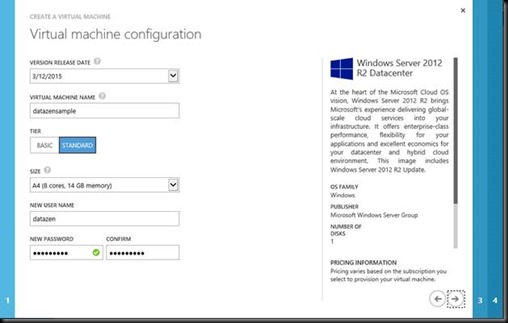




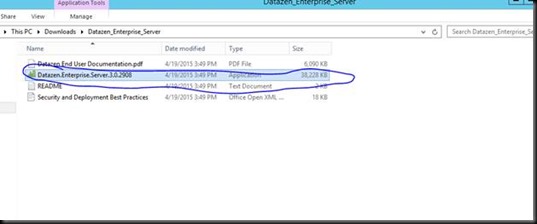






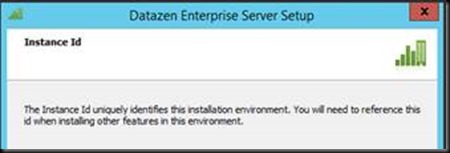

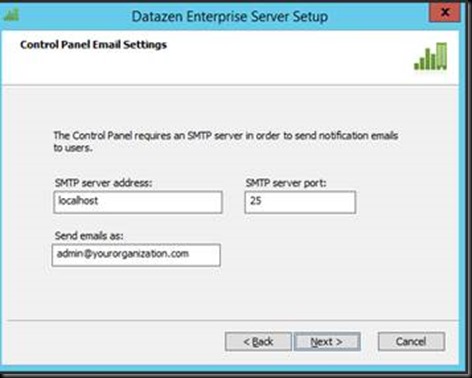










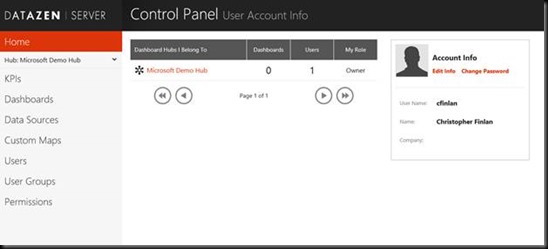



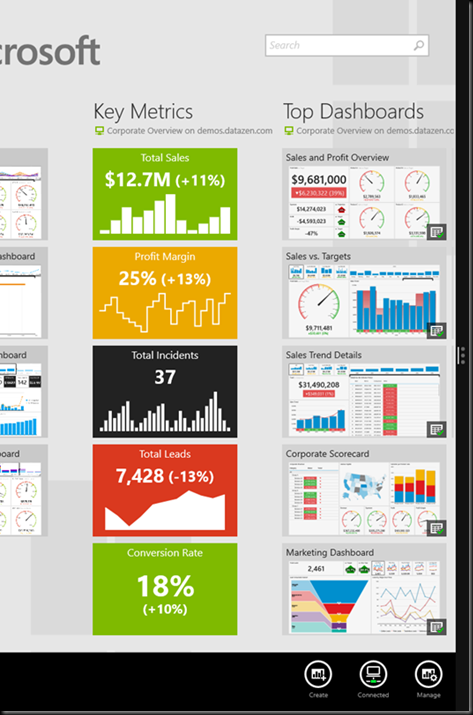




This is a great blog.
I followed the blog to install the Datazen Server in my Azure VM. However, in the following step, I don’t have the “Microsoft Branding Package” which I can upload. Where can I find that? Thanks.
“To add a brand package you’ve created, click on the branding link on the left hand side and simply upload the brand package to the server. Make sure you choose the Server to upload it to, and not the hub.”
LikeLike
What a great article. Thanks for sharing!
LikeLike
and how to deploy some stuff from DEV to PROD servers??? 🙂
Except through a backup restore process (which is not a deployment solution)
LikeLike
Hi Christopher,
Great post. I used it to setup my Azure test bed.
It worked great for a while, but suddenly when I try to publish from a remote machine, it gives a server error. Then on the server, if you go to “Server Users”, the user I am using to publish is locked out of the site. I uncheck the box, but next time I publish, it errors out and locks out the account.
I have tried this with multiple users and same result.
I can’t find a reference to this anywhere on the web.
Any ideas?
Thanks,
Ric
LikeLike
Hi Ric,
Are you using the Windows 7 app for publishing?
LikeLike
Hi Christopher,
Well, just when I thought I was out of the woods, it is happening again.
I have published a couple of dashboards, and now it wonât allow me publish anymore giving me this error:
Once, I get this error, I have to go to the server and edit the user in which case, the user has now been locked out:
When I publish again it gives me the same result.
I am using an Azure VM for my Datazen enterprise server.
No matter what I do, I cannot publish a dashboard.
I have google for this error and have not found any reference at all to this problem or seen anybody else have it.
Do you have any ideas where I can turn to resolve this?
I am trying to setup a demo server for my client so it is only for proof of concept, but leaves me dead in the water.
Thanks,
Ric
From: Ric Miller [mailto:info@floatinghome.com] Sent: Monday, September 07, 2015 4:26 PM To: ‘Christopher Finlan’ Subject: RE: [New comment] How to setup a test/dev Datazen Server instance in Microsoft Azure
Hi Christopher,
Yes I am using Win 7 and the Publisher Preview.
On the off-chance that I configured something wrong, I unistalled and re-installed and have not had that problem since.
Seems like there are some caching problems with the client and/or server.
Thanks for replying to my message but I am off and running now.
Thanks,
Ric
LikeLike
Hi Ric, the Windows 7 app is still in preview and there are some things being worked through. I’d recommend leveraging the current app in the Windows store in Windows 8 or Windows 10 if possible and see if you’re having the same issues.
LikeLike
Hi Christopher,
Thanks for the info.
I’ll try the Windows 8 app and see if that helps.
Thanks,
Ric
LikeLike
p.s. I only have one user besides admin and that user is the owner of the hub and publisher.
From: Ric Miller [mailto:info@floatinghome.com] Sent: Monday, September 07, 2015 7:29 PM To: ‘Christopher Finlan’ Subject: RE: [New comment] How to setup a test/dev Datazen Server instance in Microsoft Azure
Hi Christopher,
Well, just when I thought I was out of the woods, it is happening again.
I have published a couple of dashboards, and now it wonât allow me publish anymore giving me this error:
Once, I get this error, I have to go to the server and edit the user in which case, the user has now been locked out:
When I publish again it gives me the same result.
I am using an Azure VM for my Datazen enterprise server.
No matter what I do, I cannot publish a dashboard.
I have google for this error and have not found any reference at all to this problem or seen anybody else have it.
Do you have any ideas where I can turn to resolve this?
I am trying to setup a demo server for my client so it is only for proof of concept, but leaves me dead in the water.
Thanks,
Ric
From: Ric Miller [mailto:info@floatinghome.com] Sent: Monday, September 07, 2015 4:26 PM To: ‘Christopher Finlan’ <comment+zhf29h1yax6-m9q8g41tqilekrsqncqth98s81uzh_w@comment.wordpress.com > Subject: RE: [New comment] How to setup a test/dev Datazen Server instance in Microsoft Azure
Hi Christopher,
Yes I am using Win 7 and the Publisher Preview.
On the off-chance that I configured something wrong, I unistalled and re-installed and have not had that problem since.
Seems like there are some caching problems with the client and/or server.
Thanks for replying to my message but I am off and running now.
Thanks,
Ric
LikeLike
Hi Ric, Did you try using the Windows 8/10 publisher? The Windows 7 app is still in preview and you may run into items here and there.
LikeLike